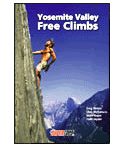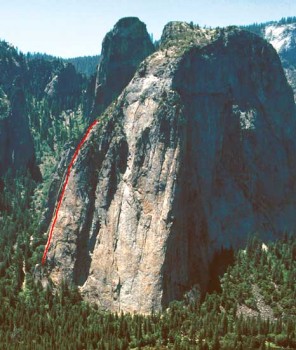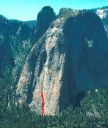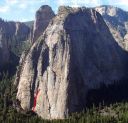East Buttress, Middle Cathedral 5.10c or 5.9 A0 |
||
Yosemite Valley, California USA | ||
| ||
|
Avg time to climb route: 8-9 hours
Approach time: 30-40 minutes Descent time: 1.5 hours Number of pitches: 11 Height of route: 1100' Overview
Included in ?50 Classic Climbs of North America,? the East Buttress clearly stands out as a Yosemite gem. Pitch after pitch of moderate Yosemite cracks are occasionally interrupted with short, well-protected crux sections. The view of El Capitan is astounding and only surpassed by the dreamy climbing moves. Solid protection and very few awkward wide sections make the East Buttress a great entry climb to long Yosemite 5.9s and 5.10s.
Photos
- View all 14 photos of East Buttress as: Thumbnails | Slideshow
Climber Beta on East Buttress
Which SuperTopo guidebooks include a topo for East Buttress?
Find other routes like
East Buttress
History
Middle Cathedral Rock rivals El Cap in an odd sort of way. It isn’t as high or as monolithic or as majestic, but it certainly has more “character” than its cross-Valley neighbor. If El Cap is gray and forbidding, much of Middle Cathedral is colorful and inviting. If El Cap defines Big Wall Climbing, then Middle Cathedral stands for Medium Wall Climbing. What can be more intriguing than Yosemite’s neglected orphan?Warren Harding craved Middle long before he became fixated on the Big Stone. In May 1954 he had pioneered, with three others, the 2,000-foot north buttress of Middle, by far the longest roped climb yet done in North America. Three months later he shifted his eyes left to the shorter but much more compact east buttress. A few hundred feet above the ground, Harding, Bob Swift, and John Whitmer twisted their way through an ant-infested tree (one of the little-known hazards of Valley climbing) and later arrived on a narrow platform below a crackless wall 40 feet high. This 65-degree slab was featureless, the biggest holds a mere quarter-inch wide. Any first ascensionist who wanted the east buttress would have to deal with this smooth wall, and no climber of the time (and very few today) could have done this unknown section free with zero protection. Artificial aid was needed and so out came the bolt kit. But down went the sun. Bob Swift remembers the next events: “It was pitch dark when we heard voices below, in the forest. Some friends of ours were worried about us and had hiked up to check. They yelled up, ‘How’s the bivouac?’ ‘Bivouac? Hell, we’re still climbing’, was Warren’s reply. The monotonous tink-tink of the hammer on the drill began again as work was started on the next bolt hole. Beside me on the belay ledge John rasped away furiously at sharpening a spare drill.” Harding, later famous for his all-night drilling session on the first ascent of The Nose in 1958, had learned this nocturnal trick in 1954! With the bolt ladder almost completed, they bivouacked and resumed climbing at dawn. The 50-foot section above the bolt ladder proved spectacular and thrilling. A long, serrated flake shot up the 70-degree wall, and the orange-colored granite was dotted liberally with knobs. It wasn’t hard, yet it wasn't trifling either. One could rest on certain knobs and the protection was excellent. The exposure was sensational. But several pitches higher the trio ran out of steam and rappelled rather than face another bivouac. The buttress now sported the longest continuous bolt ladder in the country—about nine. Bolts were not controversial back in 1954 and this ladder occasioned little comment at the time. In retrospect, however, this attempt can be seen as a radical Valley event. The old-timers had first sought out climbs with “inaccessible” summits like the Higher Spire and later routes that had natural lines, like the Column and Lower Brother. Harding was one of the first to see that hundreds of routes would open up if one simply placed a few bolt ladders to connect crack systems. (Much later, however, Harding’s “excessive” use of bolts would cause a great rift in the climbing community.) Little competition for routes existed in 1954 and Harding waited nine months before returning, knowing the route would remain virginal. Bob Swift and newcomer Jack Davis joined him on Memorial Day Weekend 1955, and thanks to the nine bolts, quickly reached the previous high point. After a bivouac near the top of the route, the trio finished the climb with alacrity and descended via the Kat Walk, the first ever to do so (William Kat, back in the 1920s, had wandered up this complex but easy route to the top of Middle). The Kat Walk later became the routine descent for many thousands of climbers. Incredibly, this classic route was done only twice more during the 1950s. This obscurity was short-lived, however. A major variation—the one followed by most today—was put up in 1961 by Yvon Chouinard and Mort Hempel. Leaving the original route not far above the bolt ladder, this duo traversed up and right to a series of superb cracks that shot upward, meeting the original line three or four pitches higher. Hundreds of adventurers did the improved route in the early 1960s, but all used aid on the bolt ladder. Then in 1965, the legendary Frank Sacherer climbed the bolt ladder free, a startling achievement for its time. – Steve Roper Strategy
Start early and bring a headlamp and warm jacket. Many people underestimate the length of the route and end up spending a night on the rock. Also, this is an exceptionally popular climb and you may get stuck behind slower climbers. Bring plenty of water.The 5.10c crux on Pitch 5 is easy to avoid by pulling on the closely spaced bolts (no aiders needed). The climbing on the 50 Crowded Variation is excellent. This variation is easier than the bolt ladder and a great opportunity to pass bottlenecked parties. After the crux pitch, there are two finishes to the climb. To the left, the original route heads up wide, strenuous, and uncrowded terrain. To the right, Pitch 6 of the recommended route opens up with a spicy section of runout 5.6 and continues up stellar finger and hand cracks. A fall for the leader or follower will result in a pendulum. Retreat
Two 50m or 60m ropes are required to retreat. The route can be rappelled from any pitch but requires leaving gear at many belay points. Retreat after Pitch 5 is difficult because the climb traverses to the right and left.ApproachIf driving from Camp 4: take Northside Drive to El Capitan Meadow. Turn left at the triangle and drive east until just before you meet Southside Drive (the one way road.) Park on the side of the road and walk 300 feet west on Southside drive to the pullout on the left (south). If driving into Yosemite Valley: on Southside Drive, park 300 feet before the turnoff to El Capitan Meadow on the paved pullout on the right From the middle of the east most pullout, locate a trail and walk 300 feet, passing a climbers’ information sign, to the Valley Loop Trail. (Don’t start from the pullout to the west or all the following distances will be wrong.) On the Valley Loop Trail, walk 300 feet right... GET Yosemite Valley Free Climbs and read the rest this approach as well beta for over 200 other classic Yosemite routes. Everything You Need to Know About
Yosemite Valley
Search the internet for beta on
East Buttress
Links to related internet pages with info on East Buttress
Other guidebooks that include info on East Buttress
|
Other Routes on Middle Cathedral
|









